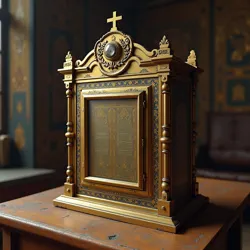Theological Authentication Procedures
Theological Authentication Procedures (TAP) represents a complex system of verification methods developed during the Religious Reform Period to authenticate religious documents, validate theological claims, and verify the credentials of religious officials. Originally established by the Bureau of Theological Authentication in 1645, these procedures became increasingly sophisticated as religious organizations sought to combat fraud and maintain doctrinal integrity.
 A preserved example of an early theological authentication device used to verify religious documents through specialized optical and chemical analysis
A preserved example of an early theological authentication device used to verify religious documents through specialized optical and chemical analysisHistorical Development
The need for formal theological authentication procedures emerged during the tumultuous period of religious reform when various factions produced competing claims of religious authority. The Fellowship of Concerned Printers had demonstrated the vulnerability of religious institutions to document forgery, leading to a crisis of authenticity in religious communications.
The initial development of TAP was overseen by Doctor Solomon Veritatis, a former member of the Society of Sanctified Surveillance who recognized the need for standardized verification methods. Working with a team of theologians, cryptographers, and document specialists, Veritatis established the fundamental principles of theological authentication in the Codex Authenticorum, a comprehensive manual that outlined methods for validating religious materials.
Core Principles
The foundational elements of Theological Authentication Procedures were based on three primary principles:
- Material Verification: The physical examination of documents, seals, and religious artifacts
- Doctrinal Consistency: The analysis of theological content for adherence to established doctrine
- Procedural Validation: The verification of the chain of custody and authorization for religious materials
These principles were codified in the Manual of Sacred Verification, which became the standard reference work for authentication specialists throughout Europe.
Methodological Framework
The TAP system employed a multi-layered approach to authentication that combined physical, theological, and procedural elements. The Department of Doctrinal Verification developed sophisticated methods for analyzing religious texts, including the Sacred Syntax System, which could identify unauthorized modifications to theological documents through careful analysis of writing style and doctrinal consistency.
Physical authentication methods included the use of specialized tools such as the Theological Spectroscope, which could analyze the composition of inks and papers used in religious documents. The Bureau of Sacred Materials maintained detailed records of authorized materials and their proper applications, allowing authenticators to identify unauthorized or fraudulent documents through material analysis.
 A period illustration showing the interior of a theological verification chamber with its characteristic arrangement of authentication devices
A period illustration showing the interior of a theological verification chamber with its characteristic arrangement of authentication devicesOrganizational Structure
The implementation of TAP required a complex organizational structure that combined religious authority with technical expertise. The Council of Authentication served as the highest authority in matters of theological verification, overseeing a network of specialized departments and bureaus.
Key organizational components included:
- The Office of Procedural Integrity, which maintained standards for authentication processes
- The Bureau of Seal Verification, specializing in the authentication of official religious seals
- The Department of Theological Concordance, which verified doctrinal consistency
- The Laboratory of Sacred Analysis, which conducted physical and chemical examinations of religious materials
Training and Certification
Becoming a certified theological authenticator required extensive training in multiple disciplines. The Academy of Sacred Verification provided comprehensive education in subjects including theology, document analysis, cryptography, and authentication procedures. Students underwent rigorous testing and practical examinations before being certified as Authentic Verifiers.
The training program, known as the Path of Verification, typically required seven years of study and practical experience. Graduates were required to take the Oath of Authentic Observation, pledging to maintain the highest standards of verification integrity.
Technical Innovations
TAP led to numerous technical innovations in document verification and authentication. The Sacred Light Analysis technique allowed authenticators to examine documents under specific lighting conditions that could reveal hidden marks or unauthorized modifications. The Theological Watermark System introduced sophisticated methods for incorporating verifiable markers into religious documents.
The development of the Authentication Matrix provided a standardized framework for evaluating religious materials, combining physical analysis with theological verification in a systematic approach. This matrix became the foundation for modern authentication procedures in many religious institutions.
Counter-Forgery Measures
As authentication procedures became more sophisticated, so did attempts to circumvent them. The Office of Counter-Deception was established to study and prevent increasingly elaborate forgery attempts. Their work led to the development of the Protective Protocols, a comprehensive system of security measures designed to prevent unauthorized reproduction of religious materials.
International Standards
The success of TAP led to its adoption by various religious organizations throughout Europe. The International Conclave of Authentication established common standards for theological verification, leading to the creation of the Universal Authentication Protocol in 1678.
The standardization of authentication procedures facilitated international religious cooperation while maintaining doctrinal integrity. The Treaty of Authentic Exchange established protocols for the verification of religious documents across jurisdictional boundaries.
Modern Applications
While many of the original TAP methods have been superseded by modern technology, their fundamental principles continue to influence contemporary approaches to religious document verification. The Institute of Religious Authentication maintains archives of historical authentication procedures while developing new methods for modern applications.
Legacy
The development of Theological Authentication Procedures had lasting impacts beyond religious document verification. Many of their principles influenced the development of modern document authentication methods, and their systematic approach to verification continues to inform security protocols in various fields.
See also
- Religious Document Security
- Verification Protocols
- Sacred Seal Authentication
- Theological Cryptography
- Historical Document Analysis
References
Primary source material for this article comes from the archived records of the Bureau of Theological Authentication, the collected manuals of the Academy of Sacred Verification, and various authenticated documents preserved by the Institute of Religious Authentication. Additional context is provided by the Archive of Historical Authentication and contemporary accounts from the Library of Sacred Procedures.